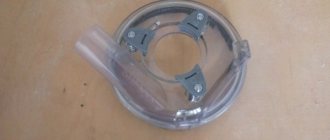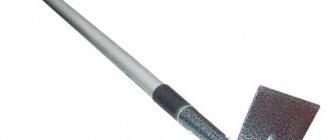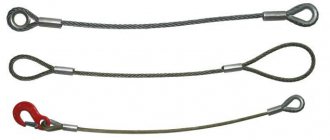Lifting work is classified as potentially dangerous, therefore all equipment used during this work is subject to special requirements in terms of their suitability for use. The condition of all components of lifting equipment is important not only for the safety of cargo, but, first of all, for the safety of the personnel carrying out the work.
The rules and regulations for the operation of such equipment, including the rejection of slings, are established by regulations and PB 10-382-00
,
POT RM-007-98
, etc. For each type of sling, the requirements for safe operation are determined by the relevant sections of
RD 24-SZK-01-01
,
RD 10-33-93
and
RD 11-07-2007
, which determine the timing and composition of control and rejection of lifting slings.
General information
1.1.
Removable load-handling devices and containers are used in the process of lifting and moving goods using lifting structures. Slinging, tying and hooking of solid loads for lifting, moving and lowering them when performing construction, installation, loading and unloading and other work using lifting structures is carried out using removable load-handling devices. Moving small-piece cargo is allowed only in special containers designed for this purpose in order to exclude the possibility of individual parts of the cargo falling out. Bricks are moved on pallets without fencing only when unloading (loading) vehicles onto the ground (and from the ground), unless otherwise specified in the operating manual (instructions) and other operational documents for the container or in the PPR. To lift and move liquid and bulk cargo, special containers are used (tubs, trays, boxes, containers, buckets, etc.).
1.2. Depending on the conditions of work, the geometric dimensions and weight of the load, lifting devices of different designs are used (slings, traverses, grips, etc.). Slings are among the simplest lifting devices in design and are flexible elements with end fastenings and gripping elements of various designs. As a rule, steel wire ropes, less often chains and tapes, are used as a flexible load-bearing element.
1.3. Steel ropes have a high specific load-bearing capacity and flexibility, are much easier to work with and more durable than ropes made from organic plant fibers or steel load chains. A steel wire rope smoothes out dynamic loads and is reliable, since the destruction of the rope does not occur suddenly, like a chain, but the number of broken wires increases gradually, which allows you to monitor the condition of the rope and reject it long before the break.
1.4. The advantages of steel chains compared to steel ropes are their high flexibility, simplicity of design, manufacturability and ability to bend around sharp edges without the use of pads. Significant disadvantages of steel chains are their large mass, the possibility of sudden rupture due to the rapid opening of formed cracks and the need for careful daily monitoring of the condition (wear) of chain links. In addition, steel chains do not allow the application of dynamic loads, and defects in the metal of the chain links are difficult to detect.
1.5. According to the number of branches, slings are divided into single-branch rope (1SC), two-branch (2SC), three-branch (3SC), four-branch (4SC) and universal (USK), single-branch chain (1SC), two-branch (2SC), three-branch (3SC), four-branch ( 4SC) and universal (USC). Simple slings (SK and STs) are used for hanging loads that have special devices (loops, hooks, eyes, bolts, etc.), universal slings are used for slinging loads with a harness. A single-leg sling with a hook or other load-grasping device is usually used to grab and move loads equipped with mounting loops or eyes, brackets, etc.
1.6. Multi-leg slings are used for lifting and moving building parts and structures that have two, three or four attachment points. They are widely used for slinging building elements (panels, blocks, trusses, etc.) equipped with loops or eyes. When using a multi-leg sling, the load must be transferred to all branches evenly, which is ensured by auxiliary connections.
1.7. Universal slings are used when lifting loads that cannot be tied with ordinary slings (pipes, boards, rolled metal, apparatus, etc.).
1.8. Traverses are used for lifting and moving long or large-sized structures or equipment (columns, trusses, beams, apparatus, pipes, etc.). Crossbars are designed to withstand compressive or tensile forces. They protect the load from the compressive forces that occur when the load is tilted and ensure safety when it is moved by a crane. Traverses are hung on the crane hook using a gusset with an eye (ring) or flexible or rigid rods that are hinged, which completely frees them from bending moments. Hanging traverses on a crane hook using rigid and flexible rods leads to loss of useful lifting height. Rope slings at the free end end with hooks of various designs that interact with product staples or pin locks mounted on a traverse with thimbles inserted into the sockets of the lock body. The pin is pulled out manually by the rope attached to it (remote control).
1.9. Grips are the most advanced and safe load-handling devices, the main advantage of which is the reduction of manual labor costs when grabbing a load and placing it in the designed position by a crane. It is advisable to use grippers in cases where it is necessary to move structures of the same type. With grips installed on the slings, you can quickly secure the sling to the rails, channels and beams being lifted. Using connecting links and rigging shackles, the grippers are quickly secured to the slings. The slings can also be used to attach hooks, sheet clamps, and other accessories.
1.10. The most common types of steel technological containers for lifting and moving piece, packaged, semi-liquid and liquid cargo, as well as cargo classified as explosive and fire hazardous, are boxes, tubs, containers, bunkers, containers, pallets and other packaging devices.
Exploitation
3.1. The specialist responsible for maintaining lifting structures in working condition is obliged to ensure that removable lifting devices and production containers are maintained in good condition (if their maintenance in good condition is not entrusted to other persons by order) by conducting periodic inspections, maintenance and repairs within the time limits established by the schedule, systematic monitoring of the correct maintenance of the inspection log and timely elimination of identified faults, as well as personal inspection of lifting devices and containers within the established time frame.
3.2. The specialist responsible for the safe performance of work using lifting structures is obliged not to allow untested, unmarked or damaged removable lifting devices and containers into work, and to provide slingers with distinctive signs.
3.3. Personnel assigned to carry out cargo hooking work, incl. in hanging lifting structures on hooks, slinging and tying loads moved by lifting structures using load-handling devices, must have a level of qualifications corresponding to the profession of slinger.
The same requirement applies to personnel of the main working professions, whose duties include hanging cargo on a hook without preliminary strapping (load that has loops, eyes, pins, located in buckets, tubs, containers or other containers), as well as in cases when the load is grabbed by semi-automatic gripping devices.
3.4. For lifting structures controlled from the floor, hooking a load onto a hook without preliminary strapping is permitted to be performed by personnel of basic working professions who have undergone testing of their skills in hooking loads and training at the workplace.
3.5. A graphic representation of slinging and hooking methods should be handed out to slingers and crane operators or posted at work sites.
3.6. Faulty load-handling devices, as well as devices that do not have tags (stamps), should not be located in the work areas. Unmarked and damaged containers are not allowed in the work areas.
3.7. Loads must be slinged in accordance with slinging diagrams. To sling a load intended for lifting, slings must be used that correspond to the weight and nature of the load being lifted, taking into account the number of branches and their angle of inclination; General purpose slings should be selected so that the angle between their branches does not exceed 90°.
3.8. The connections between the hook of the lifting machine and the suspensions, loops and thimbles of the slings must be reliable. The sling suspension must be secured with a hook latch. The mounting loop must be secured with a latch in the hook link of the sling.
3.9. In order to prevent loads from falling during lifting and moving them by lifting structures, the following slinging rules should be observed:
when tying the load, the slings must be applied without knots or twists;
Under sharp corners of metal weights (channels, angles, I-beams) it is necessary to place pads. In this case, it is necessary to take into account the location of the center of gravity of the load. The sling should be placed under the load in such a way as to prevent it from slipping while lifting the load. The load must be tied in such a way that during its movement, the fall of its individual parts is prevented and a stable position of the load is ensured during movement. To do this, slinging of long loads (poles, logs, pipes) must be done in at least two places;
The ends of the multi-leg sling that are not used for hooking must be strengthened so that when moving the load by crane, the possibility of these ends touching objects encountered along the way is excluded.
3.10. When moving a load, load-handling device or container horizontally, it should first be lifted 500 mm above equipment, building structures and other objects encountered along the way.
3.11. It is allowed to lower the transported load only to the place intended for this purpose, where the possibility of falling, tipping over or sliding of the installed load is excluded. At the place where the load is installed, pads of appropriate strength must first be laid so that the slings can be easily and without damage removed from under the load.
3.12. When carrying out work with the use of PS, lifting a load covered with earth or frozen to the ground, laid down by other loads, as well as releasing pinched slings, ropes, chains using a lifting machine is not allowed.
Question 1. On what grounds should a hook be rejected?
The hook is rejected if:
Hook horn bent
· Wear of the hook in the throat exceeds 10% of the original section height
· There are chips and cracks on the hook
Question 2. Who should inspect the slings and when?
The slinger must check the serviceability of removable load-handling devices every day before starting work. The person responsible for the good condition of removable load-handling devices - every 10 days. The inspection is carried out in accordance with the instructions defining the inspection procedure and methods, and rejection indicators. Damaged slings identified during the inspection must be removed from work. The results of the inspection of slings are recorded in the inspection log of removable load-handling devices.
Question 3. What is the breaking force of a rope?
Breaking force (P) is the force under which the rope breaks. The breaking force depends on the design of the rope and the tensile strength of the wires.
When designing, ropes must be checked by calculation using the formula:
P ≥ kxS
where k is the safety factor (determined from the table), S is the maximum tension of the rope branches.
If the certificate gives the total breaking force of the rope wires, then the breaking force can be determined by the formula:
P = Pc x 0.83
where Рс – total breaking force, 0.83 – coefficient.
Question 4. Frequency of measuring ground resistance and its value.
The resistance of grounding devices must be measured at least once a year. The resistance of grounding devices must be no more than 4 ohms.
Question 5. Select a sling for a load weighing _____ tons.
Having determined the weight of the load being lifted, the slinger must select the correct sling, taking into account the load that occurs in each of its branches. The sling is selected according to its load capacity and length. The lifting capacity of the sling is selected based on the weight of the load being lifted and the number of branches of the sling on which the load is lifted. To do this, the weight of the load is divided by the number of branches of the sling. It should be taken into account that the angle between the branches should not exceed an angle of 900.
Ticket No. 10
Question 1.What information should be written on the faucet stencil board?
Cranes in operation must be provided with signs indicating:
· Inventory number
Registration number
· Passport g/p
Dates of the next WHAT
Dates of the next technical training
Question 2. When and under what loads is the crane tested? Full and partial technical examination.
During their standard service life, cranes undergo periodic technical inspection:
· Partial (WHAT) at least once every 12 months
· Complete (PTO) at least once every 3 years, with the exception of rarely used cranes
Rarely used load-lifting cranes are subjected to technical inspection at least once every 5 years. The classification of cranes into the category of rarely used is carried out by the owner in agreement with Rostekhnadzor authorities.
The technical examination must be carried out by an engineering and technical worker to supervise the safe operation of load-lifting cranes, with the participation of an engineer and technical worker responsible for maintaining the load-lifting cranes in good condition (shop mechanic).
During PHE, the crane must be subjected to:
· Inspection
· Static tests
· Dynamic tests
Hooks, blocks, metal structures of the crane, cabin, ladders, platforms and fences, wires and grounding, crane tracks, ropes and their fastenings, lighting and alarm devices are subject to inspection.
Static testing of the crane is carried out with a load 25% greater than its rated load capacity. The crane is installed above the supports of the crane track, and its trolley is in a position corresponding to the greatest deflection of the bridge. The test load is lifted by crane to a height of 200-300 mm and maintained in this position for 10 minutes. After the time has elapsed, the load is lowered, after which the absence of residual deformation of the crane bridge is checked. If there is residual deformation resulting from testing the crane with a load, the crane is not allowed to operate.
Dynamic testing of the crane is carried out with a load whose mass is 10% greater than its rated lifting capacity, and is aimed at checking the operation of its mechanisms and brakes. During this test, repeated (at least 3 times) lifting and lowering of the load is carried out, as well as checking the operation of all other mechanisms when combining the working movements provided for in the crane operating manual.
With WHAT, static/dynamic tests are not performed.
The results of the technical examination are recorded in his passport by an engineering and technical worker supervising the safe operation of cranes, indicating the date of the next examination.
The procedure for inspection and rejection of removable lifting devices and containers
4.1. According to the requirements of the “Safety Rules for hazardous production facilities where lifting structures are used” (approved by order of Rostechnadzor dated November 12, 2013 N 533), slingers and crane operators (operators) must inspect lifting devices before their use, and acceptance indicators should be used, given in their manual (instructions) for their operation.
4.2. Specialists responsible for maintaining lifting structures in working condition and specialists responsible for the safe performance of work using lifting structures inspect lifting devices within the following periods:
traverse, pincers, grippers and containers - every month;
slings (except for rarely used ones) - every 10 days;
rarely used removable lifting devices - before starting work.
4.3. When inspecting rope slings, it is necessary to pay attention to the condition of the ropes, thimbles, hooks, hangers, locking devices, clips, carabiners and their attachment points.
4.4. To assess the safety of using ropes, the following criteria are used:
the nature and number of wire breaks, including the presence of wire breaks at the end seals, places where wire breaks are concentrated, the intensity of the increase in the number of wire breaks;
strand break;
surface and internal wear;
surface and internal corrosion;
local reduction in rope diameter, including core rupture;
deformation in the form of waviness, basket-like shape, extrusion of wires and strands, crushing of strands, creases, etc.;
damage due to temperature effects or electrical arcing.
4.5. The rope sling is subject to rejection if the number of visible breaks in the outer wires exceeds that indicated in the table.
| Double lay rope slings | Number of visible wire breaks in a section of rope sling length | ||
| 3d | 6d | 30d | |
| 4 | 6 | 16 | |
Note. d is the diameter of the rope, in millimeters.
4.6. Rejection of sling parts (rings, loops and hooks) should be carried out:
in the presence of cracks;
when the surface of elements wears out or local dents lead to a decrease in cross-sectional area by 10%;
in the presence of residual deformations leading to a change in the original size of the element by more than 5%.
4.7. The following slings are not allowed for use:
having defects;
if the marking tag is missing or damaged;
with deformed thimbles or their wear with a reduction in cross-section by more than 15%;
having cracks on pressed bushings or when their size changes by more than 10% from the original;
with signs of rope displacement in the braid or bushings;
with damaged or missing braids or other protective elements in the presence of protruding ends of the wire at the braiding point;
with hooks without safety locks.
4.8. The chain sling is subject to rejection if the following defects are found:
broken link;
bending or wear of the hook in the link is more than 10% of the original size;
chain link elongation of more than 3% of the original size;
reduction in the cross-sectional diameter of a chain link due to wear of more than 10%.
4.9. When inspecting grippers, it is necessary to check the condition of the working surfaces in contact with the load. If they have a notch, then blunting or chipping of the teeth is not allowed. The gripper must be rejected if bends, breaks in the arms or wear and damage to the connecting links are detected. Metal traverses consisting of beams, struts, frames and other elements are subject to rejection if deformations with a deflection of more than 2 mm per 1 m of length are detected, cracks in places of sharp bends or changes in the cross-section of welded elements, as well as damage to fastening and connecting links.
4.10. When inspecting containers, you must especially carefully check:
the appearance of cracks in gripping devices for slinging;
serviceability of actual devices and lid locking devices;
absence of defects in welded joints, integrity of markings.
The container is rejected in the following cases:
the container is not marked;
the purpose of the container is not indicated;
there are faulty sling units;
the sides are dented or torn;
there are cracks and other defects in welded joints.
4.11. When inspecting polymer-based textile slings, it is necessary to pay attention to the condition of the tapes, seams, hooks, staples, locking devices, clips, carabiners and places of their fastenings. Slings should not be allowed to work if:
there is no mark (tag) or the information about the sling, which contains information about the manufacturer and load-carrying capacity, is not readable;
there are knots on the load-bearing tapes of the slings;
there are transverse cuts or tears in the tape, regardless of their size;
there are longitudinal cuts or tears in the tape, the total length of which exceeds 10 percent of the length of the tape of the sling branch, as well as single cuts or tears more than 50 millimeters in length;
there are local delaminations of the sling tapes (except for places where the edges of the tapes are sealed) over a total length of more than 0.5 meters on one extreme seam or on two or more internal seams, accompanied by a break in three or more seam lines;
there are local delaminations of the sling tapes in the place where the edges of the tape are sealed for a length of more than 0.2 meters on one of the outer seams or on two or more internal seams, accompanied by a tear in three or more seam lines, as well as peeling of the edge of the tape or stitching of the tapes at the loop along the length more than 10 percent of the length of the sealing (stitching) of the ends of the tapes;
there are surface breaks of the belt threads with a total length of more than 10 percent of the belt width, caused by mechanical action (friction) of the sharp edges of the load;
there is damage to the belts from exposure to chemicals (acid, alkali, solvent, petroleum products) with a total length of more than 10 percent of the belt width or sling length, as well as single damage of more than 10 percent of the belt width and a length of more than 50 millimeters;
there is bulging of threads from the sling tape at a distance of more than 10 percent of the tape width;
there are through holes with a diameter of more than 10 percent of the width of the tape from the impact of sharp objects;
there are burnt through holes with a diameter of more than 10 percent of the width of the tape from exposure to splashes of molten metal or the presence of three or more holes with a distance between them of less than 10 percent of the width of the tape, regardless of the diameter of the holes;
there is contamination of the belts (petroleum products, resins, paints, cement, soil) of more than 50 percent of the sling length;
there is a combination of all of the above defects in an area of more than 10 percent of the width and length of the sling;
there is loosening or wear of more than 10 percent of the width of the sling loops.
It is prohibited to use slings with the following defects and damage to metal elements (rings, loops, staples, pendants, clips, carabiners, links):
cracks of any size and location;
wear on the surface of elements or the presence of local dents, leading to a decrease in cross-sectional area by 10 percent or more;
the presence of residual deformations leading to a change in the original size of the element by more than 3 percent;
damage to threaded connections and other fasteners.
4.12. The results of inspection of removable lifting devices and containers must be recorded in a special journal.
Rejection standards for steel rope slings
These lifting devices are single- or multi-strand, loop or ring products, the basis of which is a high-strength steel rope.
During the inspection of such slings, the responsible employee must pay attention to:
- compliance of the parameters and characteristics of the device with the information displayed on the tag;
- integrity, loops, core, thimbles;
- condition of external and internal strands.
Reason for rope rejection
I can be:
- unsuitability for further use of the core;
- wear of outer strands by more than 40%;
- reduction in diameter (due to corrosion - more than 7%, from 3% - with a non-rotating cable and 10% or more when the core is deformed);
- damage to thimbles with simultaneous loss of 15% of the cable thickness;
- deformation of bushings and loss of more than 10% of thickness;
- displacement of the cable in relation to the elements fixing it;
- a condition in which individual wire elements protrude significantly from the braid;
- increased waviness, creases, twisting of the rope;
- damage caused by exposure to extreme temperatures or electrical discharges;
- if there is no tag or readable information on it.
There are certain standards for breaks depending on the length of the rope. If during inspection it is revealed that they are exceeded, the cable is rejected
inevitable. These are the norms:
- for ropes with a length of 3 own diameters - 4 breaks;
- for products whose length is equal to 6 of their own diameters - 6 breaks;
- for cables with a length of 30 own diameters - 16 breaks.
Moreover, if the wear of the outer wires of the rope
is defined at the level of 30% of its diameter, and also if wear has led to a decrease in the diameter itself by 5 percent or more, the norms we are talking about are divided into two.
Repair
5.1. Restoration repairs involving welding of load-handling devices, containers and their elements must be carried out in specialized organizations that have technical means and qualified specialists.
5.2. Routine repair of elements of lifting devices and containers without the use of welding (straightening parts, sealing ends of ropes, replacing fasteners, etc.) must be performed by mechanics for the repair and maintenance of hydraulic lifting equipment, in accordance with the repair documentation and under the guidance of a specialist responsible for the maintenance of lifting structures in working condition
5.3. Information about the quality of individual repair work must be entered in the repair log. When accepting a lifting device or container from repair, it is necessary to inspect and test it in order to determine the degree of reliability.











